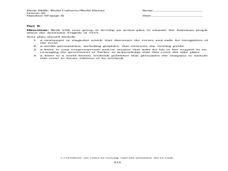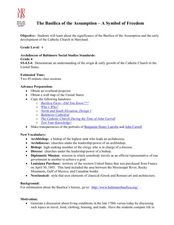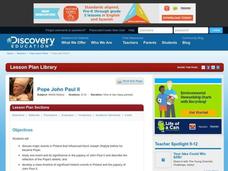Curated OER
An Interview With the Past: Ancient Roman and U.S. Government Leaders
Young scholars produce a modern television interview show where they present information about Ancient Rome and its influence on modern governments. In this governments lesson plan, students produce shows in groups.
Curated OER
The Fall of the Roman Empire and the Armenian Tragedy of 1915
Students examine the fall of the Roman Empire and the Armenian tragedy. In this world history lesson, students read handouts about both world history events and create presentations that feature the events.
Curated OER
The Basilica of the Assumption-A Symbol of Freedom
Fourth graders explore the importance of the Basilica of Assumption and the development of the Catholic Church in Maryland. In this social studies lesson, 4th graders discuss the Basilica of the Assumption and the Catholic Church.
Curated OER
Struggles for Power
Learners investigate the leaders of the Roman Empire. In this ancient Rome instructional activity, students research the contributions of Augustus, Tiberius, Caligula, Claudius I, and Nero. Learners write obituaries that feature the...
Curated OER
Civilizations: Rise To Power
Students discover details about the rise of civilizations. In this Roman history lesson, students watch "Civilizations: Rise to Power," and read primary sources from different periods of the empire's history. Students write essays that...
Curated OER
The Byzantine Empire: Icon Adoration
Students identify the worship of icons as a division between the Roman Catholic Church and the Orthodox Church. For this lesson on the Byzantine Empire, the teacher provides a simulation showing a basic division in students. The teacher...
Curated OER
Pope John Paul II
Students discover the accomplishments of Pope John Paul II. In this world history lesson, students research selected websites about the history of Poland, the accomplishments of Pope John Paul II, and...
Curated OER
An Ancient Greek and Roman Festival
Third graders label a map of ancient Greek and Roman civilizations and do a written report on one element of these two cultures. They participate in discussions of food, farming, daily life and government (among others). Students use the...
Curated OER
Ancient Rome Vocabulary Quiz
For this ancient Rome vocabulary worksheet, students match vocabulary word to definitions, 14 words total. Worksheet is labeled as a quiz, but may be used for practice or review.
Curated OER
The Roman Army
Ninth graders examine the Roman Army. In this World History lesson, 9th graders practice their skills in researching. Students create a poster on the Roman Army.
Curated OER
Roman Empire: Physical Framework - Location, Borders, Dimensions
Students relate the classical world to the modern world. In this map skills lesson plan, students turn a blank map into a colorful complete map by following step-by-step directions. This lesson plan allows students to connect our current...
Curated OER
Ancient Rome Group Creative Writing
In this ancient Rome writing activity, students collaborate to write a piece about ancient Rome using the 15 vocabulary terms listed.
Curated OER
Ancient Rome Word Search Worksheet
In this ancient Rome vocabulary worksheet, students locate and mark the 14 words and names listed in the word bank within the word search puzzle.
Curated OER
COMING TO AMERICA:A PILGRIM STORY LESSON
By completing this lesson, learners demonstrate their reading comprehension skills, including reading strategies, inference, literal meaning, and critical analysis.
Curated OER
Why Study History?
Students interpret historical evidence presented in primary and secondary resources. In this world history lesson, students research several historical events and their impact. Students compose essays that address the question, "Why...
Curated OER
Justinian I
Students research emperor Justinian I in this lesson. They identify the contributions of Theodora to Justinian's rule, and the expansion of the Byzantine Empire during this time. They then analyze the contributions of Byzantine on...
Curated OER
Objects Then and Now
What ancient Roman objects perform the same tasks as modern objects? In this activity, students are asked to identify 5 illustrations of Roman objects. Students are then prompted to compare these objects with the functions of 5 modern...
Curated OER
The 1848 Revolution, the Second Reich, and the First World War
High schoolers explore the events that led up to World War I. In this World History lesson, students read an article on Germany and World War I, then answer four study questions and write an essay about the article.
Curated OER
Trajan's Rome: The Man, The City, The Empire
Incorporate six lessons on Trajan and ancient Rome into a social studies unit on the Roman Empire. From Trajan's birth to his rise to greatness, the resource uses primary source documents and historical commentary to connect...
Curated OER
Friendship in Julius Caesar
High schoolers examine the vocabulary used to show friendship in Shakespeare's, Julius Caesar. In this Julius Caesar lesson, students discuss their idea of friendship and what it means to them. They work in pairs to determine how same...
Curated OER
Primary Sources and Archaeology in the Study of Ancient Mediterranean Trade
Tenth graders begin the lesson by plotting trade routes, major empires and items traded. Using primary sources, they examine their own values regarding trading items for royality. They participate in a role-play exercise in which they...
Curated OER
Gladiators: Rome's Violent Past
Ninth graders examine the role of public entertainment in Ancient Rome. In this World History lesson plan, 9th graders imagine themselves as a participant at a gladiator game at the Roman Colosseum. Students write a personal...
Curated OER
Ancient Roman Influences in Israel and the Modern World
Students practice critical thinking skills. They compare Ancient Roman influences on the Middle East region (Beit Shean, Masada, and Zippori) with Ancient Roman influences still present in our culture today.
Curated OER
Greco-Roman Origin Myths
Students explore myths that explain the world, recognize some characters of Greco-Roman mythology and their symbols, and Make personal connections to the theme by writing and drawing a myth of their own.























